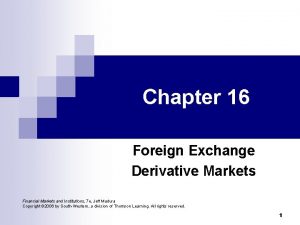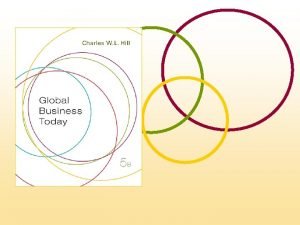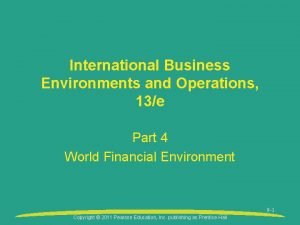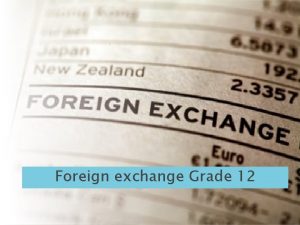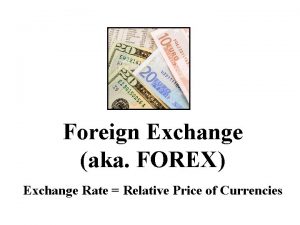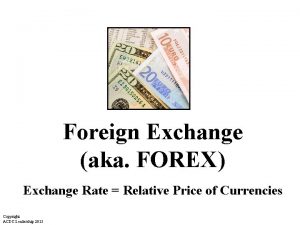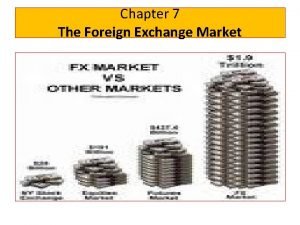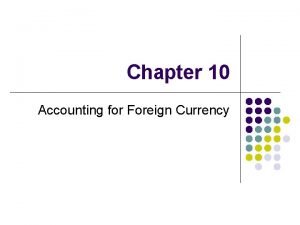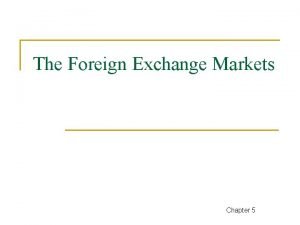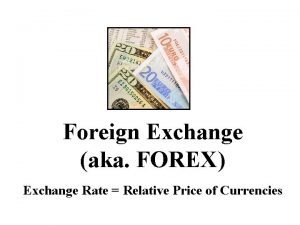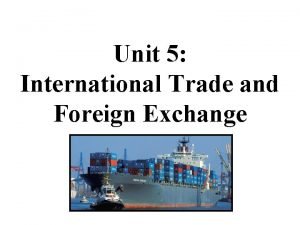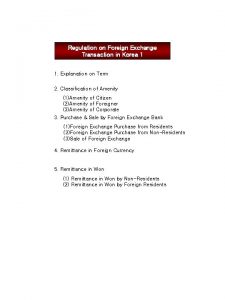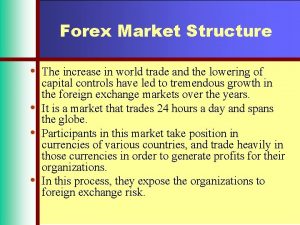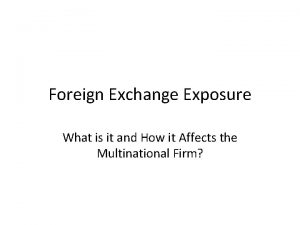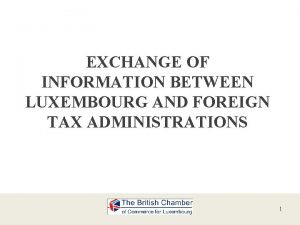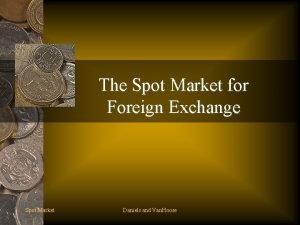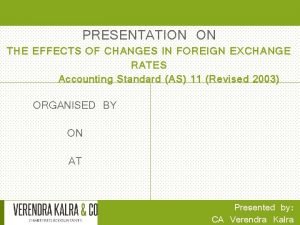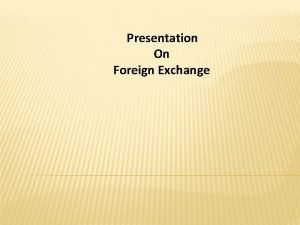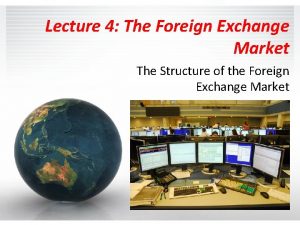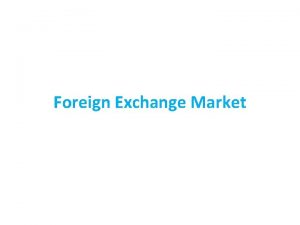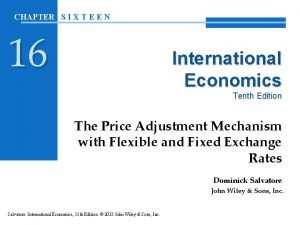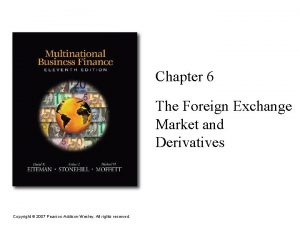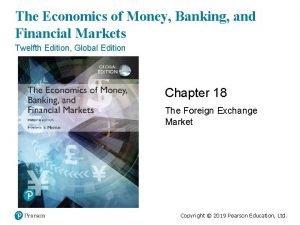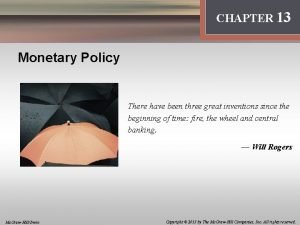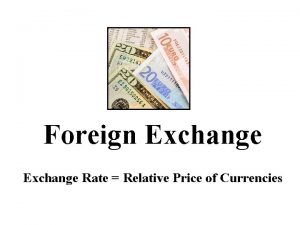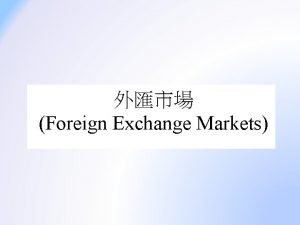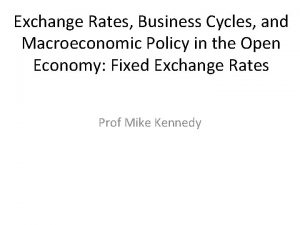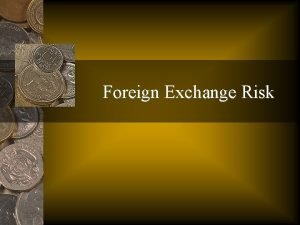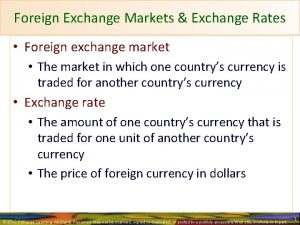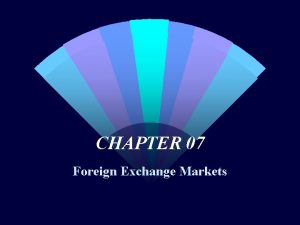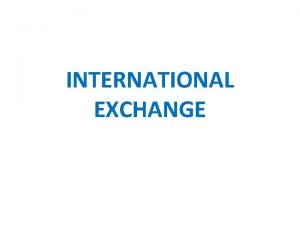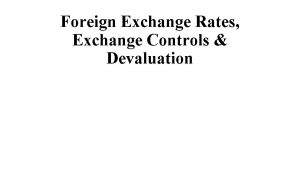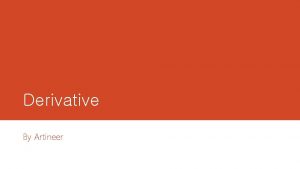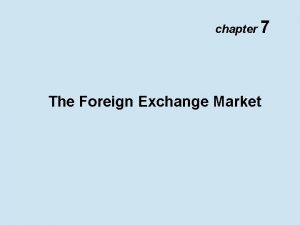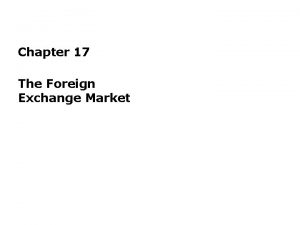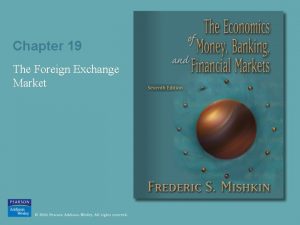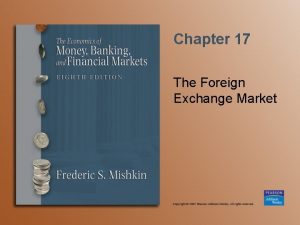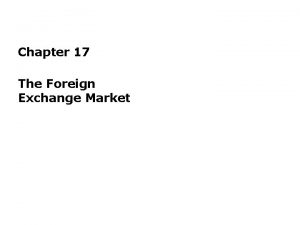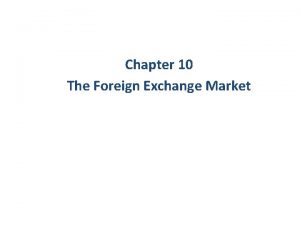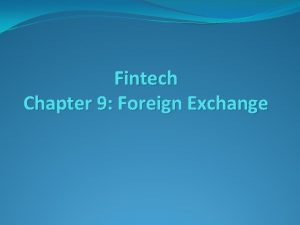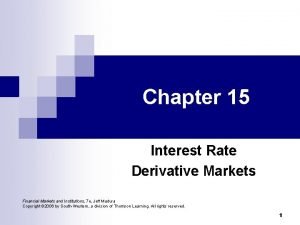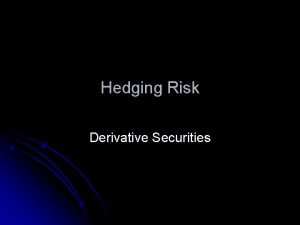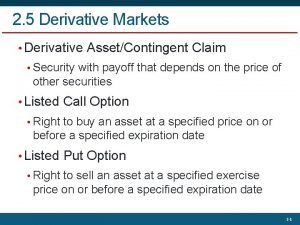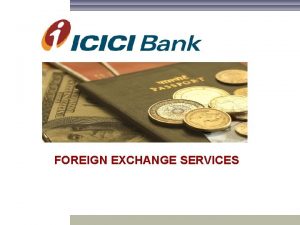Chapter 16 Foreign Exchange Derivative Markets Financial Markets






































- Slides: 38

Chapter 16 Foreign Exchange Derivative Markets Financial Markets and Institutions, 7 e, Jeff Madura Copyright © 2006 by South-Western, a division of Thomson Learning. All rights reserved. 1

Chapter Outline n n n n n Background on foreign exchange markets Factors affecting exchange rates Movements in exchange rates Forecasting exchange rate volatility Speculation in foreign exchange markets Foreign exchange derivatives International arbitrage Explaining price movements of foreign exchange derivatives 2

Background on Foreign Exchange Markets n Foreign exchange markets consist of a global telecommunications network among large commercial banks that serve as financial intermediaries ¨ n n Banks are located in New York, Tokyo, Hong King, Singapore, Frankfurt, Zurich, and London The bid price is always lower than the ask price Institutional use of foreign exchange markets The degree of international investment by financial institutions is influenced by potential return, risk, and government regulations ¨ Institutions are increasing their use of the foreign exchange markets because of reduced information and transaction costs ¨ 3

Background on Foreign Exchange Markets (cont’d) Financial Institution Participation in Foreign Exchange Market Commercial banks ØServe as financial intermediaries in the foreign exchange market by buying or selling currencies ØSpeculate on foreign currency movements by taking long positions in some currencies and short positions in others ØProvide forward contracts to customers ØOffer currency options to customers, which can be tailored to a customer’s specific needs International mutual funds ØUse foreign exchange markets to exchange currencies when reconstructing their portfolios ØUse foreign exchange derivatives to hedge a portion of their exposure Brokerage firms and investment banking firms ØEngage in foreign security transactions for their customers or for their own accounts 4

Background on Foreign Exchange Markets (cont’d) Financial Institution Participation in Swap Market Insurance companies ØUse foreign exchange markets when exchanging currencies for their international operations ØUse foreign exchange markets when purchasing foreign securities for their investment portfolios or when selling foreign securities ØUse foreign exchange derivatives to hedge a portion of their exposure Pension funds ØRequire foreign exchange of currencies when investing in foreign securities for their stock or bond portfolios ØUse foreign exchange derivatives to hedge a portion of their exposure 5

Background on Foreign Exchange Markets (cont’d) n Exchange rate quotations ¨ The spot exchange rate is for immediate delivery ¨ Forward rates indicate the rate at which a currency can be exchanged in the future ¨ Cross-exchange rates n Some quotations express the exchange rate between two non-dollar currencies 6

Computing A Cross-Exchange Rate The euro is worth $1. 15, and the Canadian dollar is worth $0. 60. What is the value of the euro in Canadian dollars? 7

Background on Foreign Exchange Markets (cont’d) n Types of exchange rate systems ¨ 1944 to 1971: the exchange rate at which one currency could be exchanged for another was maintained within 1 percent of a specified rate (the Bretton Woods era) ¨ 1971: an agreement among major countries (Smithsonian Agreement) allowed for devaluation of the dollar and a widening of the boundaries to 2. 25% ¨ 1973: boundaries were eliminated and exchange rates of major countries were allowed to float n n Dirty float Freely floating system 8

Background on Foreign Exchange Markets (cont’d) n Types of exchange rate systems (cont’d) ¨ Pegged n exchange rate systems Some currencies may be pegged to another currency or a unit of account and maintained within specified boundaries ERM until 1999 ¨ Hong Kong since 1983 ¨ Argentina from 1991 until 2002 ¨ n A country that pegs its currency does not have complete control over its local interest rates 9

Background on Foreign Exchange Markets (cont’d) n Types of exchange rate systems (cont’d) ¨ Classification of exchange rate arrangements Many countries allow the value of their currency to float against others, but governments intervene periodically to influence its value n Many governments attempt to impose exchange controls to prevent their exchange rate from fluctuating n ¨ When controls are removed, the exchange rate abruptly adjust to a new market-determined level 10

Factors Affecting Exchange Rates n The value of a currency adjusts to changes in demand supply ¨ In equilibrium, there is no excess or deficiency of that currency n n If a currency increases in value, it appreciates If a currency decreases in value, it depreciates ¨ Exchange rates are influenced n Differential inflation rates n Differential interest rates n Government intervention by: 11

Factors Affecting Exchange Rates (cont’d) n Differential inflation rates ¨ n Differential interest rates ¨ n Purchasing power parity (PPP) suggests that the exchange rate will change by a percentage that reflects the inflation differential between the two countries of concern Interest rate movements affect exchanges rates by influencing the capital flows between countries Central bank intervention Central banks attempt to adjust a currency’s value to influence economic conditions ¨ Direct intervention occurs when a country’s central bank sells some of its currency reserves for a different currency ¨ 12

Factors Affecting Exchange Rates (cont’d) n Indirect intervention ¨ The Fed can affect the dollar’s value indirectly by influencing the factors that determine its value n ¨ Indirect intervention during the Peso Crisis n ¨ The central bank increased interest rates to discourage foreign investors from withdrawing their investments in Mexico’s debt securities Indirect intervention during the Asian Crisis n ¨ e. g. , the Fed can attempt to lower interest rates by increasing the money supply, which puts downward pressure on the dollar Some Asian countries increased their interest rates to encourage investors to leave their funds in Asia Indirect intervention during the Russian crisis n The Russian central bank attempted to prevent outflows by tripling interest rates 13

Factors Affecting Exchange Rates (cont’d) n Foreign exchange controls ¨ Controls, such as restrictions on the exchange of a currency, can be used as a form of indirect intervention n e. g. , Venezuela imposed foreign exchange controls in the mid-1990 s ¨ Under severe pressure, governments tend to let the currency float temporarily toward its market-determined level 14

Forecasting Exchange Rates n n Market participants take derivative positions based on their expectations of future exchange rates Technical forecasting involves the use of historical exchange rate data to predict future values ¨ n e. g. , time-series models that examine moving averages and allow the forecaster to develop some rule Fundamental forecasting is based on fundamental relationships between economic variables and exchange rates ¨ e. g. , high inflation in a country can lead to depreciation in its currency 15

Forecasting Exchange Rates (cont’d) n Market-based forecasting is the process of developing forecasts based on the spot rate or the forward rate ¨ Use of the spot rate n Corporations can use the spot rate to forecast, since it represents the market’s expectation of the spot rate in the near future ¨ Use of the forward rate n Speculators would take positions if there was a large discrepancy between the forward rate and expectations of the future spot rate ¨ e. g. , if the forward rate for the pound was $1. 40 and the spot rate was expected to be $1. 45, everyone would buy pounds forward and sell them at the future spot rate 16

Forecasting Exchange Rates (cont’d) n Mixed forecasting involves using a combination of forecasting techniques ¨ No single technique has been found to be consistently superior ¨ Each of the techniques is assigned a weight, and the more reliable techniques receive a higher weight ¨ The actual forecast used by an MNC is a weighted average of the various forecasts developed 17

Forecasting Exchange Rate Volatility Participants forecast exchange rate volatility to develop a range surrounding their forecast n To develop a volatility forecast: n ¨ Determine the relevant period of concern ¨ Decide on a method to forecast volatility n e. g. , historical exchange rate volatility, time series of volatility patterns, implied standard deviations 18

Speculation in Foreign Exchange Markets n Commercial banks take positions in currencies to capitalize on expected exchange rate movements 19

Speculating on Expected Exchange Rate Movements Zena Bank expects the euro to depreciate against the dollar and plans to take a short position in euros and a long position in dollars. Assume the following: 1. Interest rate on borrowed euros is 5 percent annualized 2. Interest rate on dollars loaned out is 6 percent annualized 3. Spot rate is € 0. 90 per dollar 4. Expected spot rate in ten days is € 0. 95 per dollar 5. Zena Bank can borrow € 10 million Describe the steps Zena should take to profit from shorting euros and going long on dollars. 20

Speculating on Expected Exchange Rate Movements (cont’d) Zena Bank should take the following steps: 1. Borrow € 10 million and convert to $11, 111 2. Invest the $11, 111 million for ten days at 6 percent annualized (or. 1667 percent over ten days), which will generate $11, 129, 630 3. After ten days, convert the $11, 129, 630 into euros at the existing spot rate, which converts to € 10, 573, 148 4. Pay back the loan of € 10 million plus interest of 5 percent annualized (. 1389 percent over ten days), which equals € 10, 013, 889 Thus, Zena earns € 559, 259 over a ten-day period. 21

Foreign Exchange Derivatives n Foreign exchange derivatives can be used to: ¨ Speculate on future exchange rate movements ¨ Hedge anticipated cash inflows or outflows in a given foreign currency n Institutional investors have increased their international investments, which has increased their exposure to exchange rate risk 22

Foreign Exchange Derivatives (cont’d) n Forward contracts are contracts typically negotiated with a commercial bank that allow the purchase or sale of a specified amount of a particular foreign currency at a specified exchange rate on a specified future date ¨ The forward market facilitates the trading of forward contracts ¨ n Commercial banks profit from the difference between the bid price and the ask price and are exposed to exchange rate risk if their purchases do not match their sales of a foreign currency Forward purchases can hedge the corporation’s risk that the currency’s value may appreciate ¨ Forward sales can hedge the corporation’s risk that the currency’s value may depreciate ¨ 23

Foreign Exchange Derivatives (cont’d) n Forward contracts (cont’d) ¨ The forward rate may sometimes exhibit a premium or discount relative to the existing spot rate: ¨ The forward premium reflects the percentage by which the forward rate exceeds the spot rate on an annualized basis 24

Computing A Forward Rate Premium or Discount Assume that the spot rate for the euro is $1. 20, while the 180 -day forward rate for the euro is $1. 22. What is the forward rate premium? 25

Foreign Exchange Derivatives (cont’d) n Currency futures contracts ¨ A currency futures contract is a standardized contract that specifies an amount of a particular currency to be exchanged on a specified date and at a specified exchange rate n n ¨ n Firms purchase futures to hedge payables Firms sell futures to hedge receivables Futures contracts have specified settlement dates Currency swaps ¨ A currency swap is an agreement that allows one currency to be periodically swapped for another at specified exchange rates n Essentially a series of forward contracts 26

Foreign Exchange Derivatives (cont’d) n Currency options contracts ¨ A currency call option provides the right to purchase a particular currency at a specified price (the exercise price) within a specified period n n ¨ Used to hedge payables in a foreign currency The option will not be exercised if the spot rate remains below the exercise price A currency put option provides the right to sell a particular currency at the exercise price within a specified period n n Used to hedge receivables in a foreign currency The option will not be exercised if the spot rate remains above the exercise price 27

Foreign Exchange Derivatives (cont’d) n Currency options contracts (cont’d) ¨ Conditional n currency options The premium is conditioned on the actual movement in the currency’s value over the period of concern ¨ The choice of a basic option versus a conditional option is dependent on the firm’s expectations of the currency’s exchange rate over the period of concern 28

Foreign Exchange Derivatives (cont’d) n Use of foreign exchange derivatives for speculating ¨ Speculators who expect the euro to appreciate could: n n n Purchase euros forward and sell them in the spot market when received Purchase futures contracts on euros and sell euros in the spot market when received Purchase call options on euros and sell the euros in the spot market if the option is exercised 29

Foreign Exchange Derivatives (cont’d) n Use of foreign exchange derivatives for speculating (cont’d) ¨ Speculators who expect the euro to depreciate could: n n n Sell euros forward and purchase them in the spot market to fulfill the obligation Sell futures contracts on euros and purchase euros in the spot market by the settlement date Purchase put options on euros and purchase the euros in the spot market if the option is exercised 30

Speculating with Currency Futures Assume the following: 1. The spot rate for the euro is $1. 15 2. The price of a futures contract is $1. 17 3. Expectation of euro’s spot rate as of the settlement date is $1. 20 What could you do to profit from your expectations? You could buy euro futures. You would receive euros on the settlement date for $1. 17 and could sell euros at $1. 20 if your expectations were correct. To account for uncertainty, you could also develop a probability distribution for the future spot rate. 31

Speculating with Currency Options Assume the following: 1. The spot rate for the euro is $1. 15 2. A call option is available with an exercise price of $1. 17 and a premium of $0. 02 per unit. 3. Expectation of euro’s spot rate as of the settlement date is $1. 20 What could you do to profit from your expectations? You could euro call options. If your expectations are correct, you will net $1. 20 – $1. 17 – $0. 02 = $0. 01 per unit. 32

International Arbitrage n n If exchange rates become misaligned, arbitrage will occur, forcing realignment Locational arbitrage is the act of capitalizing on a discrepancy between the spot rate at two different locations by purchasing the currency where it is priced low and selling it where it is priced high ¨ Some financial institutions watch for locational arbitrage opportunities, so any discrepancy in exchange rates is quickly corrected 33

Conducting Locational Arbitrage Assume the following information: Bid Rate on Euros Ask Rate on Euros Blythe Bank $1. 18 $1. 19 Slythe Bank $1. 20 $1. 21 What actions could an arbitrageur take to benefit from these quotes? An arbitrageur could conduct locational arbitrage by purchasing euros from Blythe Bank for $1. 19 and selling them to Slythe Bank for $1. 20. 34

International Arbitrage (cont’d) n Covered interest arbitrage ¨ Interest rate parity refers to the relationship between a forward rate premium and the interest rate differential of two countries: n n If the interest rate is lower in the foreign country than in the home country, the forward rate of the foreign currency should exhibit a premium The forward rate premium or discount should be about equal to the differential in interest rates between the countries of concern 35

Computing A Forward Premium Using Interest Rate Parity Assume that the spot rate of the British pound is $1. 50, the one-year U. S. interest rate is 7 percent, and the one-year British interest rate is 8 percent. What should the forward rate premium or discount of the British pound be? The forward rate reflects a 0. 93% discount below the spot rate, or $1. 49. 36

International Arbitrage (cont’d) n Covered interest arbitrage (cont’d) ¨ If interest rate parity does not hold, covered interest arbitrage is possible n E. g. , if the spot rate and forward rate for a foreign currency are equal and the foreign interest rate is higher, arbitrageurs would buy the currency now, invest in the foreign country, and sell the currency forward Interest rate parity prevents investors from earning higher returns from covered interest arbitrage than can be earned in the U. S. ¨ Impact of the September 11 Crisis ¨ n The interest rate differential between the U. S. and other countries increased, resulting in increased forward rate discounts 37

Explaining Price Movements of Foreign Exchange Derivatives n Indicators of foreign exchange derivative prices ¨ The spot rate influences the forward rate and currency futures ¨ Indicators that may signal a change in economic conditions that will affect the supply and demand for a particular currency and the spot rate are monitored: n n Relative inflation Relative interest rates Economic growth indicators Relative budget deficits 38
 Foreign exchange and international financial markets
Foreign exchange and international financial markets Foreign exchange derivative
Foreign exchange derivative Too foreign for here too foreign for home
Too foreign for here too foreign for home When entering foreign markets basic entry
When entering foreign markets basic entry Entering foreign markets
Entering foreign markets Why study financial market
Why study financial market Foreign exchange process
Foreign exchange process Exchange rate grade 12
Exchange rate grade 12 Foreign exchange shifters
Foreign exchange shifters 4 forex shifters
4 forex shifters Functions of foreign exchange market
Functions of foreign exchange market Forex accounting
Forex accounting Objective of foreign exchange
Objective of foreign exchange Xlri international exchange
Xlri international exchange Forex shifters
Forex shifters International trade and foreign exchange
International trade and foreign exchange Foreign exchange transaction regulation korea
Foreign exchange transaction regulation korea Markets
Markets Forex market structure
Forex market structure Types of foreign exchange exposure
Types of foreign exchange exposure Christophe joosen
Christophe joosen Nominal effective exchange rate
Nominal effective exchange rate Spot market in foreign exchange market
Spot market in foreign exchange market Integral and non integral foreign operations
Integral and non integral foreign operations Foreign exchange meaning
Foreign exchange meaning Exchange rates maths lit grade 12
Exchange rates maths lit grade 12 Structure of foreign exchange market
Structure of foreign exchange market Foreign exchange market features
Foreign exchange market features Salient features of fema
Salient features of fema Stability of foreign exchange market
Stability of foreign exchange market Foreign exchange market example
Foreign exchange market example Foundation for worldwide international student exchange
Foundation for worldwide international student exchange Foreign exchange market graph
Foreign exchange market graph Foriegn exchange market graph
Foriegn exchange market graph Foreign exchange graph
Foreign exchange graph Foreign exchange market
Foreign exchange market Foreign exchange forward contract
Foreign exchange forward contract Foreign exchange worksheet
Foreign exchange worksheet Exchange rate diagram
Exchange rate diagram

